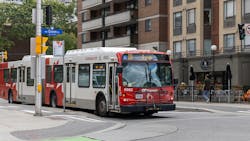Ottawa City Council approves Transportation Master Plan Capital Infrastructure Plan
The city of Ottawa, Ontario’s, Transportation Master Plan (TMP) Capital Infrastructure Plan was approved by City Council, guiding development of the city’s transportation system to 2046.
The plan identifies the transit, road and active transportation investments that are required to support Ottawa’s projected growth, creating a connected and livable city. It lays the foundation for long-term, coordinated investment in Ottawa’s transportation system. It also informs annual budgets, the development charges background study and the city’s long-range financial plans.
The Capital Infrastructure Plan includes the following two networks for both transit and road projects:
- The Needs-based Networks identifies all projects needed to address the city’s mobility needs to 2046, based on the official plan’s population and employment growth projections.
- The Priority Networks identify a subset of projects that should be prioritized for implementation, based on affordability within the city’s long-range financial plans.
The projects were prioritized using a council-approved framework. These investments focus on delivering the most essential and cost-effective infrastructure to encourage sustainable mobility, accommodate growth to 2046 and improve access across Ottawa.
The city notes its transit-first approach ensures that road investments were only considered where transit would not be enough to meet travel demand. The plan adds road capacity projects, including road widenings and new roads or road extensions that support growth by providing access to development and addressing congestion bottlenecks. Pedestrian, cycling and transit facilities will be incorporated as appropriate in all road capacity projects, as per the city’s complete streets policy.
The TMP also includes the prioritized list of council-approved active transportation projects, identifying sidewalk and cycling improvements for the first phase of implementation in the next seven to 10 years. These projects target critical walking and cycling missing links and network expansion opportunities where no other works are planned. They add or upgrade facilities such as bridges, major structures, sidewalks, street crossings, multi-use pathways, bike lanes and cycle tracks.
The Priority Road and Transit Networks include approximately C$3.9 billion (US$2.8 billion) in city-led capital projects, with C$2.3 billion (US$1.6 billion) in transit projects and C$1.6 billion (US$1.1 billion) in road projects.
